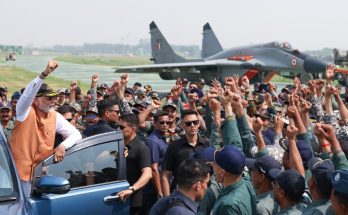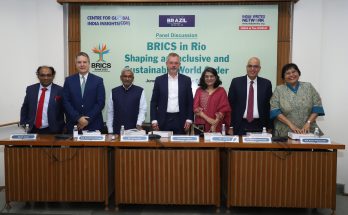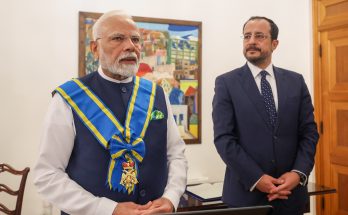
The prospects of peace and stability in the Korean Peninsula have never been brighter, but looking ahead, it will entail give-and-take and steadfast political will to bring the process to fruition, says Vishnu Prakash, India’s former ambassador to South Korea and Canada
A dept at theatrics, the mercurial American President Donald Trump made an astounding appraisal of Chairman Kim Jong-un, hours within meeting him on June 12 at Singapore -“He’s got a very good personality, he’s funny, and he’s very, very smart ….He’s a great negotiator, and he’s a very strategic kind of a guy.” And the very next day at Washington, Trump declared: “There is no longer a nuclear threat” from Pyongyang. This was a stunning reversal from his rhetoric merely a few months ago, when he had threatened North Korea with “fire and fury” like the world had “never seen before.” Another American president had similarly looked his Russian counterpart in the eye and “found him to be very straightforward and trustworthy…. I was able to get a sense of his soul”. (US’ then President George Bush said to his counterpart Russian President Vladimir Putin during Slovenia summit in 2001)
The Korean Conundrum
So, has the Korean conundrum been resolved and if so what led to such an abrupt change? Will the parties honour their side of the bargain? What are the prospects of denuclearization in the Korean Peninsula (KP) and ramifications thereof especially for India? How important was South Korean (ROK) President Moon Jae-in’s role? These are overwhelming questions that continue to be the subject of speculation by Korea-watchers worldwide.

After the 1950-53 inter-Korean war, the two halves went their separate ways. By the turn of the century ROK was a vibrant democracy with a flourishing economy. The isolated and paranoid North (DPRK) became a hermit kingdom, ruled by three generations of autocratic KIMs. Poverty-stricken and facing an existential crisis, it took to development of WMD (Weapons of Mass Destruction) to deter external (read USA) aggression.
Under young Kim
Jong-un, who took over the reins in 2011 at the age of 29, upon his father’s death, efforts to fabricate an advanced WMD arsenal gathered pace. Ever since 2011, DPRK has conducted 86 missile tests since 2011 – 20 in 2017 alone – as compared to 16 during Kim’s father’s 17 year rule. Four of the six nuclear tests were also undertaken during the same period. In November 2017 the North successfully tested Hwasong-15 ICBM (Intercontinental Ballistic Missile), with a range of 13,000 km bringing the US mainland within its reach. That was a wakeup call for the US and crossed its tolerance threshold.
Tensions Soar
The year 2017 was particularly rough for the Korean Peninsula, with both sides engaging in belligerent rhetoric and name-calling. The danger of conflict was looming large. US President Donald Trump forced the UN Security Council to tighten and impose debilitating sanctions on DPRK, choking its meagre exports and avenues of critical foreign currency. Even China, the North’s sole ally and lifeline, was arm-twisted into falling in line. As it is, Beijing was pretty upset with Pyongyang for its sabre-rattling and adventurism.

Olive Branch
On January 1 this year, Kim surprised the world with an offer of peace and dialogue with South Korea. He announced a moratorium on further WMD tests and even promised denuclearization if security guarantees were provided. Like sunlight bursting through menacing clouds, the atmosphere virtually changed overnight. ROK, which shudders at the thought of conflict, knowing the scale of death and devastation it will wreck, immediately grabbed the offer. A series of meetings and engagements followed leading to the third inter-Korean summit on April 27. The leaders met like long-lost cousins. They agreed to a phased disarmament, cessation of hostilities and pledged to conclude a peace accord during the year. Kim and Moon have had two more interactions since, with the latter also stepping up his mediatory role Pyongyang and Washington.
Trump’s Big Surprise
Meanwhile, Trump, too, sprang a surprise in early March by agreeing unconditionally to meet Kim. For decades the DPRK leadership had been seeking a face-to-face interaction with the American President but had been rebuffed. It transpires that even during the height of public brinkmanship, Washington and Pyongyang had maintained multiple channels of discreet contact. President Moon’s gentle diplomacy was also instrumental in nudging Trump, though he had his own reasons too. Priding himself as a ‘deal maker’ and embroiled in controversies, Trump needed a big success story. He sensed an opportunity to script history.
Denuclearisation: Extent, Pace & Sequence
As preparatory talks commenced, the US demanded an upfront commitment to complete verifiable and irreversible denuclearisation (CVID) from DPRK. This was a deal-breaker for Pyongyang, which had staked everything over the decades for the development of its nukes and missiles, as an insurance for regime survival. Also, Kim had learnt to trust nothing and nobody, especially the Americans. DPRK has been witness to the fate of dictators like Qaddafi and Saddam Hussein, who had abandoned their nuclear programme. It is particularly worried that hawks like US Vice-President Mike Pence, Secretary of State Mike Pompeo and National Security Advisor John R. Bolton, all votaries of regime change in North Korea, now have the ear of Trump.
Washington went all out to pile pressure on Pyongyang. Trump even announced the cancellation of the proposed summit on May 24. Kim, an accomplished poker player himself, remained unfazed, forcing the American president to reverse his decision within 36 hours. In a volte-face, the US side also conceded that denuclearisation was a process, that would require time. This was a diplomatic coup for Kim, who held few bargaining chips, other than his country’s WMD programme.
Trump-Kim Summit
Under unprecedented media glare and public scrutiny, the two leaders met as equals, for the first-ever US-DPRK summit on June 12 in Singapore. Trump was out to charm Kim. They signed a short joint statement in which Kim committed to complete denuclearisation of the Korean Peninsula. It was vague at best, without any timelines. Nonetheless, sanctions are to stay till denuclearisation. Later in the day, Trump announced the suspension of the US – South Korea joint annual military exercises, conceding yet another North Korean demand.
A few pointers can be discerned at this stage. One, North Korea is a de-facto nuclear weapon state and no NWS has ever disarmed. Two, notwithstanding his posturing, Trump was bold enough to thrash out a realistic and reasonable deal, that has brightened the prospects of success. An arrangement that Pyongyang had perceived as one-sided and onerous, would have faltered, as in the past. Three, having effectively secured NWS status, Kim is keen on embracing economic development and shedding his nation’s pariah status. He is fully in control, has studied in Switzerland and is more likely to walk the talk. Four, eventually DPRK is likely to halt and offer the IAEA-monitored freeze on its advanced WMD programme (short of completely giving up its nuclear option), to alleviate American concerns. In return, it would demand a Peace Accord, massive developmental assistance and normalisation of ties. All eyes are now on the second summit between Trump and Kim that is likely to happen soon.

High stakes for Seoul
South Korea will happily go along, as it knows that the North has no strategic need to deploy WMD against it, given the geographical proximity and the latter’s conventional weapons capability. President Moon, a life-long advocate of dialogue and engagement with Pyongyang, is impatient to resume economic exchanges and people-to-people contacts. Japan, forced to watch from the sidelines, remains unconvinced but can do little expect to entreat the US. The biggest loser in this great game is China, which has historically treated DPRK as a buffer but has effectively been dealt out of the negotiations this time around. Given its fraught relations with the US it has had to content with courting Kim (whom it had shunned since 2011) to safeguard its interests and stay in the reckoning.
India & North Korea
India has a limited role in the Korean Peninsula, though it has maintained diplomatic relations with both Koreas since 1973. New Delhi’s ties with Seoul have flourished over the years, but floundered with Pyongyang, especially since the mid-90s when North Korea’s clandestine nuclear and missile cooperation with Pakistan came to light. North Korea’s irresponsible behaviour has directly impinged on India’s security. New Delhi will feel reassured once DPRK’s WMD programme is brought under international safeguards. India would also be quite willing to resume trade with DPRK after the sanctions are lifted.
Give and Take
In sum, for considerations outlined above, the prospects of peace and stability in the Korean Peninsula have never been brighter. However, the toughest part lies ahead as the sides get down to nitty-gritty. It will entail long, strenuous and patient negotiations, lots of give and take and steadfast political will, on all sides to bring the process to fruition. One has learnt to expect the unexpected from the Korean theatre. Hopefully this time around there would be no last-minute surprises.
(This article has been published in the latest edition of India and World magazine , a venture of TGII Media Private Limited and India Writes Network. To subscribe to the magazine, check https://www.indiawrites.org/tgii-india-world-inside/ or write to editor@indiawrites.org)
Author Profile
- India Writes Network (www.indiawrites.org) is an emerging think tank and a media-publishing company focused on international affairs & the India Story. Centre for Global India Insights is the research arm of India Writes Network. To subscribe to India and the World, write to editor@indiawrites.org. A venture of TGII Media Private Limited, a leading media, publishing and consultancy company, IWN has carved a niche for balanced and exhaustive reporting and analysis of international affairs. Eminent personalities, politicians, diplomats, authors, strategy gurus and news-makers have contributed to India Writes Network, as also “India and the World,” a magazine focused on global affairs.
Latest entries
 India and the WorldJune 26, 2025Operation Sindoor: India Sheds Restraint, Rediscovers Utility of Force
India and the WorldJune 26, 2025Operation Sindoor: India Sheds Restraint, Rediscovers Utility of Force India and the WorldJune 23, 2025BRICS summit in Rio to focus on Global South, local currency trade
India and the WorldJune 23, 2025BRICS summit in Rio to focus on Global South, local currency trade Africa InsightsJune 11, 2025New Opportunities in India-Japan Cooperation in Africa
Africa InsightsJune 11, 2025New Opportunities in India-Japan Cooperation in Africa India and the WorldMay 23, 2025Post-Operation Sindoor, India reminds Turkey, China of concerns and sensitivities
India and the WorldMay 23, 2025Post-Operation Sindoor, India reminds Turkey, China of concerns and sensitivities







